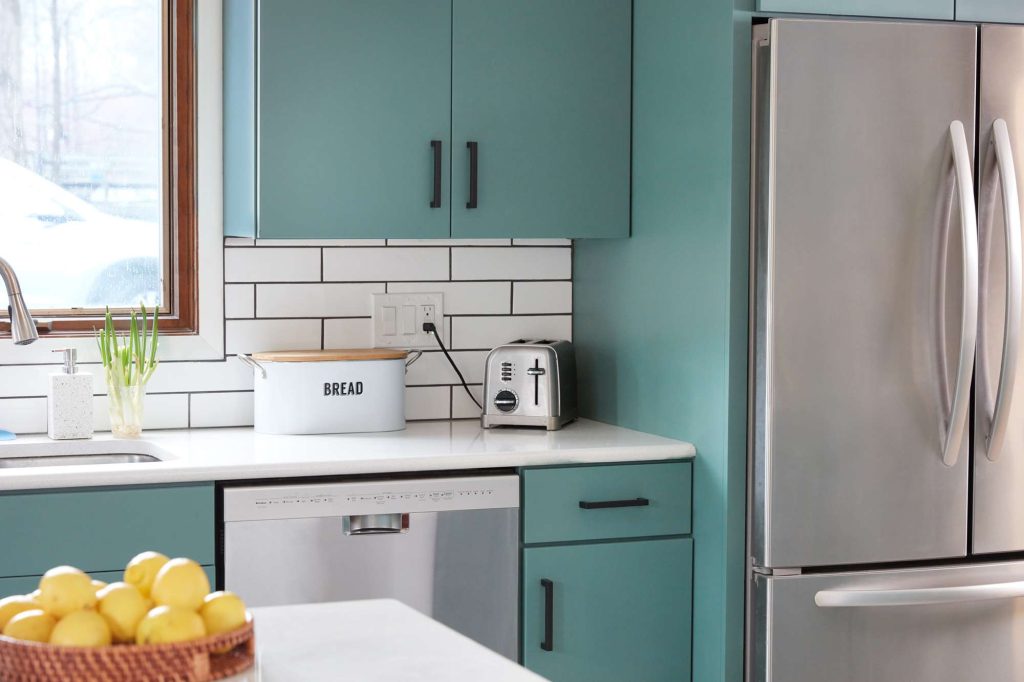A kitchen uses more electricity than any other room in the home, and the National Electrical Code stipulates that kitchens should be amply served by multiple circuits. In a kitchen that uses electrical cooking appliances, this can mean it needs as many as seven or eight circuits. Compare this to the requirements for a bedroom or other living area, where a single general-purpose lighting circuit can serve all the light fixtures and plug-in outlets.
At one time, most kitchen appliances were plugged into ordinary general outlet circuits, but as kitchen appliances have become larger and larger over the years, it’s now standard—and required by building code—for each of these appliances to have a dedicated appliance circuit that serves nothing else. In addition, kitchens require small appliance circuits and at least one lighting circuit.
Be aware that not all local building codes have the same requirements. While the NEC (National Electrical Code) serves as the basis for most local codes, individual communities can, and often do, set their own standards. Always check with your local code authorities on requirements for your community.
-
01
of 07Refrigerator Circuit
A modern refrigerator requires a dedicated 20-amp circuit. You may currently have a smaller refrigerator plugged into a general lighting circuit, but during any major remodeling, install a dedicated circuit (120/125-volts) for the refrigerator. For this dedicated 20-amp circuit, 12/2 non-metallic (NM) sheathed wire with a ground is required for the wiring.
This circuit usually does not require GFCI protection unless the outlet is within 6 feet of a sink or located in a garage or basement, but it generally does require AFCI protection.
-
02
of 07Range Circuit
An electric range generally needs a dedicated 240/250-volt, 50-amp circuit. That means that you’ll need to install a 6/3 NM cable (or #6 THHN wire in a conduit) to feed the range. If it’s a gas range, however, it will only require a 120/125-volt receptacle to power the range controls and vent hood.
During a major remodel, though, it’s a good idea to install the electric range circuit, even if you won’t currently be using it. In the future, you may want to convert to an electric range, and having this circuit available will be a selling point if you ever sell your house. Keep in mind that an electric range needs to push back to the wall, so position the outlet accordingly.
While 50-amp circuits are typical for ranges, some units may require circuits as large as 60 amps, while smaller units may require smaller circuits—40-amps or even 30-amps. However, new home construction typically includes 50-amp range circuits, since these are sufficient for the vast majority of residential cooking ranges.
In kitchens where a cooktop and wall oven are separate units, the National Electrical Code generally allows both units to be powered by the same circuit, provided that the combined electrical load does not exceed the safe capacity of that circuit. However, typically the use of 2-, 30-, or 40- amp circuits are run from the main panel to power each separately.
-
03
of 07Dishwasher Circuit
When installing a dishwasher, the circuit should be a dedicated 120/125-volt, 15-amp circuit. This 15-amp circuit is fed with a 14/2 NM wire with a ground. You may also elect to feed the dishwasher with a 20-amp circuit using 12/2 NM wire with a ground. Be sure to allow enough slack on the NM cable so that the dishwasher can be pulled out and serviced without disconnecting it—your appliance repairman will thank you.
Note: a means of local disconnection or panel lock-out is required for dishwashers. This requirement is met via a cord and plug configuration or a small lockout device mounted on the breaker at the panel to prevent shock.
Some electricians will wire a kitchen so the dishwasher and garbage disposal are powered by the same circuit, but if this is done, it must be a 20-amp circuit and care must be taken to make sure the total amperage of both appliances does not exceed 80 percent of the circuit amperage rating. Check with local code authorities to see if this is allowed.
GFCI and AFCI requirements vary from jurisdiction to jurisdiction. Usually, the circuit requires GFCI protection, but AFCI protection may not be required, depending on the local interpretation of the code.
-
04
of 07Garbage Disposal Circuit
Garbage disposals do the dirty work of cleaning up the messes after meals. When loaded down with garbage, they use a good bit of amperage as they grind up the refuse. A garbage disposal requires a dedicated 15-amp circuit, fed by a 14/2 NM cable with a ground. You may also elect to feed the disposer with a 20-amp circuit, using 12/2 NM wire with a ground. This is often done when the local code allows the disposal to share a circuit with the dishwasher. You should always check with your local building inspector to see if this is allowed in your locale.
Different jurisdictions may have different requirements requiring GFCI and AFCI protection for garbage disposals, so check with your local authorities. Including both AFCI and GFCI protection is the safest approach, but because the GFCIs can be prone to “phantom tripping” due to motor start-up surges, professional electrician often omit GFCIs on these circuits where local codes allow it. AFCI protection is generally required since these circuits are operated by a wall switch and the disposal may be wired to plug into a wall outlet.
Continue to 5 of 7 below. -
05
of 07Microwave Oven Circuit
The microwave oven needs a dedicated 20-amp, the 120/125-volt circuit to feed it. This will require 12/2 NM wire with a ground. Microwave ovens come in different varieties and sizes. Some are countertop models, and other microwaves mount above the stove.
Although it’s not uncommon to see microwave ovens plugged into standard appliance outlets, larger microwave ovens can draw as much as 1500 watts, and these need their own dedicated circuits.
This circuit does not need GFCI protection in most areas, but it is sometimes required where the appliance plugs into an accessible outlet. AFCI protection is usually required for this circuit since the appliance is plugged into an outlet. However, microwaves contribute to phantom loads, so you might want to consider unplugging them when not in use.
-
06
of 07Small Appliance Circuits
Atop your counter-top you will need two dedicated 20-amp, 120/125-volt circuits to run your small appliance loads, including devices such toasters, electric griddles, coffee pots, blenders, etc. Two circuits are the minimum required by code; you can also install more if your needs require them.
When planning the circuits and the location of outlets, try to imagine where you will place appliances on your countertop. If in doubt, add additional circuits for the future.
Circuits powering plug-in receptacles serving countertop appliances should always have both GFCI and AFCI protection.
-
07
of 07Lighting Circuit
Of course, a kitchen wouldn’t be complete without a lighting circuit to brighten the cooking area. At a minimum, one 15-amp, 120/125-volt dedicated circuit is required to power the kitchen lighting, such as the ceiling fixtures, canister lights, under-cabinet lights, and strip lights.
Each set of lights should have its own switch, allowing you to control the lighting. Always consider future needs, as well. You may want to add a ceiling fan in the future, or maybe a bank of track lights. For this reason, it’s not a bad idea to install a 20-amp circuit for the general lighting use, even though code only requires a 15-amp circuit.
In most jurisdictions, a circuit that supplies only lighting fixtures does not require GFCI protection, but it may be required if a wall switch is located near the sink. AFCI protection is generally required for all lighting circuits.
Kitchen Wiring in Older Homes
In older homes that have not had their kitchen’s wiring systems updated, it is very common for kitchen wiring to be undersized for the electrical demands of a modern kitchen. It is not uncommon, for example, for a kitchen to have only two or three circuits, and for basic appliances such as the refrigerator, dishwasher, garbage disposal to be powered by the same general-purpose circuit that powers the light fixtures and countertop receptacles. Generally speaking, older wiring systems are allowed to remain in place (“grandfathered in”) when a kitchen undergoes modest remodeling efforts, such as simple replacement of appliances, flooring, and countertops. However, during major remodeling projects that require building permits, you may be required to bring your kitchen fully “up to code,” and this very likely will require adding several electrical circuits.
Kitchen Wiring in Newer or Remodeled Kitchens
During new construction or major kitchen remodeling, the building code will likely require that you bring both the plumbing and wiring systems into alignment with the current code requirements. This often involves adding electrical circuits and adding GFCI and/or AFCI protection. GFCIs have long been required in kitchens, but AFCI protection is a more recent addition.
AFCI protection: Beginning with the 2014 National Electrical Code revision and extended in the 2017 revision, a special type of circuit protection became required for many circuits in the home, including the kitchen. Known as AFCI (arc-fault circuit interrupters), these devices are designed to sense sparking (arcing) that occurs when electricity jumps between faulty wire connections. AFCIs shut down the current flow before a fire can occur.
In kitchens, the best advice is to make sure that all 15-amp and 20-amp circuits have AFCI protection. While this can be provided by special AFCI outlets, it is more typically done by installing circuit breakers with built-in AFCI protection. It’s important to note that AFCI protection is different than GFCI protection, and it does not replace those requirements. GFCI (ground-fault circuit interruption) protection, on the other hand, is about protecting against shock.
Many kitchen circuits require both AFCI and GFCI protection. In these instances, an electrician may install combination GFCI/AFCI circuit breakers, or they may use AFCI circuit breakers in combination with GFCI outlet receptacles.
There is by no means consensus on the requirements for AFCI protection in a kitchen. Even within a single jurisdiction, different inspectors may have different interpretations of the requirements. In some areas, any circuit that is served by a plug-in receptacles or wall switches requires AFCI protection, while elsewhere, the requirement is for AFCI protection for all 15-amp or 20-amp circuits, even those serving only hardwired appliances. The only way to be sure is to consult your local authorities before doing any circuit work in a kitchen.
Adding the necessary AFCI protection must be done whenever circuit work is done in the home. A professional electrician may be obliged to add some form of AFCI protection whenever working on a kitchen circuit, even for work as basic as replacing a single outlet receptacle.
Here is a list of the required electrical circuits in new kitchen construction or a major remodel.
Read the full article here









